Land Invertebrates
Media
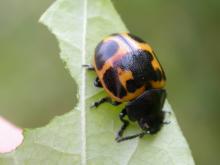
Species Types
Scientific Name
Labidomera clivicollis
Description
The swamp milkweed leaf beetle is found on the various milkweeds it eats, often in grassy areas or on roadsides. The exact pattern of orange and black varies among individuals.
Media

Species Types
Scientific Name
Meloe spp.
Description
Blister beetles in the genus Meloe are called oil beetles because of a yellowish oil they excrete from their joints when squeezed or distressed. This oil contains cantharidin, an irritating chemical that can cause blistering in many people.
Media
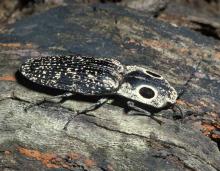
Species Types
Scientific Name
Alaus oculatus
Description
The eyed click beetle is only one of about 1,000 species of click beetles in North America. Most of the others are drab in comparison.
Media
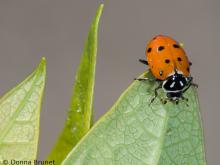
Species Types
Scientific Name
Hippodamia convergens
Description
One of our many native lady beetles, the convergent lady beetle is named for two short white lines on the black pronotum (shoulderlike section behind the head) that converge toward each other.
Media

Species Types
Scientific Name
Cycloneda munda
Description
The polished lady beetle lacks spots. One of our many native lady beetles, it eats aphids, which endears it to gardeners and farmers.
Media

Species Types
Scientific Name
Neoharmonia venusta
Description
The V-marked lady beetle, one of our many native lady beetles, is very attractive. The pattern and coloration can vary greatly among individuals, but most in this species have a V on the back.
Media

Species Types
Scientific Name
Brachiacantha quadripunctata
Description
Not all Missouri lady beetles are red with black spots. The four-spotted lady beetle reverses the pattern.
Media
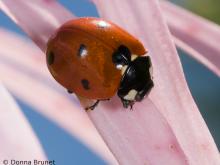
Species Types
Scientific Name
Coccinella septempunctata
Description
The seven-spotted lady beetle is native to Eurasia and was introduced to our continent to combat aphid pests. It is now well established in North America.
Media

Species Types
Scientific Name
Charidotella sexpunctata
Description
The golden tortoise beetle is shiny metallic gold or orange, and the edges of the elytral shields are transparent. It eats plants in the morning glory family.
Media
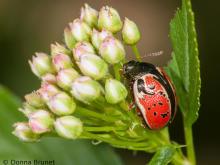
Species Types
Scientific Name
Calligrapha spiraea
Description
The ninebark calligraphy beetle is one of nearly 40 North American calligraphy beetles, named for the scrawly markings on their backs. Most calligraphy beetles require particular host plants.
See Also



Media

Species Types
Scientific Name
Cisseps fulvicollis
Description
The yellow-collared scape moth is more often “orange-collared.” And whether you think it looks more like a firefly or a wasp, it’s still a moth!
Media

Species Types
Scientific Name
Nearly 150 species in North America north of Mexico
Description
Slim, delicate plume moths are instantly recognizable by their T-shaped silhouette, long legs, and muted shades of tan and brown. It can be hard to separate the various species.
Media

Species Types
Scientific Name
Pyrrharctia isabella
Description
Not many people know the adult Isabella tiger moth when they see one, but we’re all acquainted with its caterpillar, the woolly worm, or woolly bear.
About Land Invertebrates in Missouri
Invertebrates are animals without backbones, including earthworms, slugs, snails, and arthropods. Arthropods—invertebrates with “jointed legs” — are a group of invertebrates that includes crayfish, shrimp, millipedes, centipedes, mites, spiders, and insects. There may be as many as 10 million species of insects alive on earth today, and they probably constitute more than 90 percent all animal species.





















